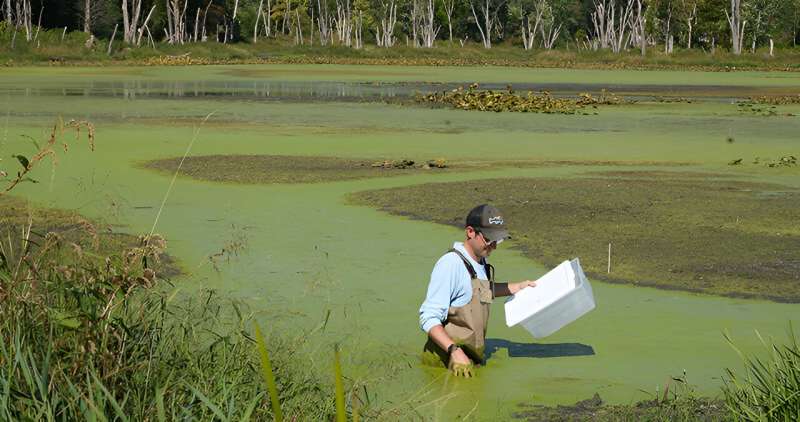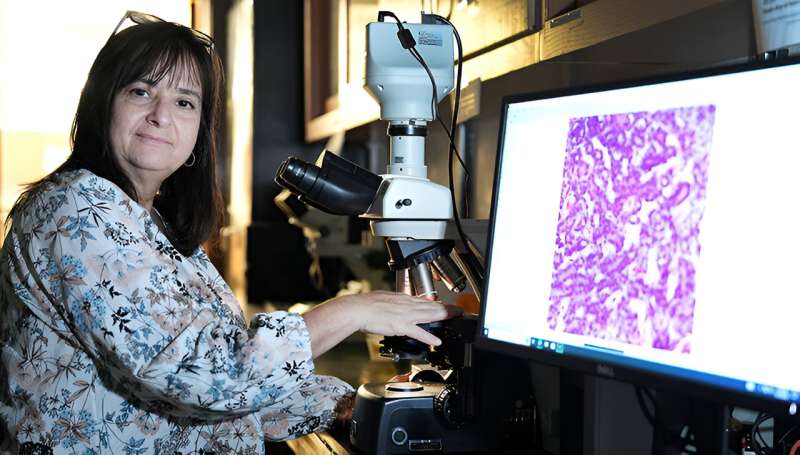This article has been reviewed according to Science X's editorial process and policies. Editors have highlighted the following attributes while ensuring the content's credibility:
fact-checked
peer-reviewed publication
trusted source
proofread
Examining the bio-impact of toxic chemical cocktails in the environment

Purdue University scientists are unraveling the complicated toxicity of a mixture of what are often called "forever chemicals" found in many consumer products.
In outdoor experiments under controlled conditions, the team found that tadpoles exposed to a common mixture of these compounds, called perfluoroalkyl and poly-fluoroalkyl substances (PFAS), suffered reduced growth as they transformed into juvenile frogs. Size at this life stage is related to the survival and reproductive success of amphibians generally, said Purdue research faculty member Tyler Hoskins.
"There are over 5,000 of these chemicals out there that we know of, and that list continues to grow as our analytical capabilities grow," Hoskins said. A common source of these chemicals is the fire-retardant aqueous film-forming foams (AFFF) that have been used for more than 50 years to douse fuel fires at airports and military sites. But PFAS are widespread environmental contaminants that are also found in fast-food packages, nonstick coatings on cookware, cosmetics, biosolid-derived fertilizers and a broad range of manufacturing processes.
"We were trying to mimic what aquatic organisms would experience if they were near a site where AFFF had been historically used. Water bodies at airports and defense sites are the areas where you would expect surface water to end up with AFFF," he said.
Hoskins and nine co-authors published their results in a paper highlighted on the cover of the journal Environmental Science & Technology.
"PFAS are perhaps the most persistent class of chemicals we have created since we started producing chemicals," said co-author Maria Sepúlveda, professor in the Department of Forestry and Natural Resources. "Studies that look at PFAS mixtures are very critical right now, and there aren't very many because they are hard to do."
Existing studies tend to examine PFAS at the cellular level in the laboratory rather than in whole animals.
A big challenge for scientists is how to sort the toxicity of various PFAS mixtures. In the field, Hoskins noted, animals become exposed to dozens of these chemicals at the same time. But when scientists run laboratory tests or outdoor studies under controlled conditions that simulate real-world environments, they often focus on exposures to three or fewer compounds.
"It's rare to look at what's actually in the environment," Hoskins said. The team designed the study to examine the relative role of one PFAS in particular—perfluorooctane sulfonate (PFOS)—as part of a mixture with four other PFAS.
The company that manufactured PFOS voluntarily phased it out in 2002. "But it's still the most commonly detected PFAS in the environment and in animals. It's a really important one to study," Hoskins said.
PFOS accumulates in biological tissue more than most PFAS chemicals and also ranks among the most toxic. The researchers had hoped to resolve whether PFOS would stand out as the most toxic chemical of the mixture. Their results suggested, however, that PFOS was no more toxic than the other four PFAS in the mixture.

The U.S. banned another class of long-lasting toxic chemicals, polychlorinated biphenyls (PCBs), in 1979. There are close to 250 types of PCBs, compared to thousands for PFAS. Scientists discovered long ago that all PCBs act in the same way.
"With PFAS, that's not the case," Sepúlveda said. "There's nothing unique that you can say, "Oh, that's PFAS exposure." There are so many different mechanisms going on that it's hard to study them because you don't know how they act."
In studies conducted over the last five years at the whole-animal level, Sepúlveda's team has seen that each chemical in the tested mixtures usually has additive effects. The pervasive nature of PFAS complicates the studies.
"If I took a blood sample from you, you're going to have a PFAS profile in your blood," Sepúlveda said. "It's composed of several chemicals, and not all of them have the same toxicity. You need to know how those might interact when they're together to impact toxicity."
The chemicals are commonly found in laboratory equipment, too. This includes glassware, plasticware and even the rabbit chow they feed the frogs.
"We found it in the tanks that leached. And worst of all, it's in the rainwater," Sepúlveda said. "How do you control for that? We can't keep the tanks sealed. It's a problem right now."
The research team has follow-up studies in progress to further study mixture toxicity in insects and in aquatic community dynamics.
"Aquatic organisms exist in a community, and they interact with one another," Hoskins said. "When one member of the community gets perturbed, that can have ripple effects for other members of the community. The community-level effects of PFAS have not received much research attention."
The team chose amphibians for this study because they have an aquatic life stage and can breed near sites affected by AFFF.
"Just like every other animal, they serve important roles in the ecosystem," Hoskins noted. They eat a lot of insects, including mosquitoes. And they serve as prey, in turn, for other animals such as herons, turtles and snakes.
"Chemicals serve a lot of important purposes for us. But if we're going to put large amounts of chemicals into the environment, it's our responsibility to understand what they're doing to our health and wildlife health," Hoskins said. "That's what we're trying to do here."
More information: Tyler D. Hoskins et al, Chronic Exposure to a PFAS Mixture Resembling AFFF-Impacted Surface Water Decreases Body Size in Northern Leopard Frogs (Rana pipiens), Environmental Science & Technology (2023). DOI: 10.1021/acs.est.3c01118
Journal information: Environmental Science & Technology
Provided by Purdue University


















